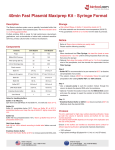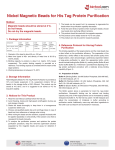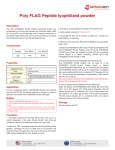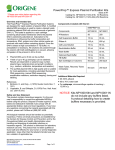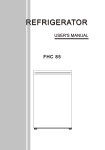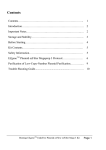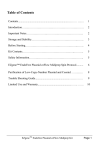Download Endofree Plasmid Maxiprep Kit-Syringe Format-User
Transcript
Endofree Plasmid Maxiprep Kit - Syringe Format Notice! Below is Steps where mistakes are easily made. Please read the following carefully! Step 5: ● ● When transferred into Filter Syringe, let stand the lysate at room temperature for 1 to 2 min until the white precipitates float to the top, then press the plunger. Optional: Spin down the lysate at 3500 rpm for 1 to 2 min to remove most of the precipitates, and then transfer the supernatant into the Filter Syringe. Step 6: ● ● Buffer RET is recommended to be pre-warmed at 50°C to dissolve salt precipitates if any exists. The solution mixture MUST be immediately filtered to avoid salt precipitation after adding Buffer RET and 100% ethanol. Step 7: ● ● Use a vacuum pump to suck the solution mixture through the column to absorb the plasmid DNA onto the membrane. Optional: Transfer the solution mixture into the BtBind DNA column and press the plunger to expel the solution to bind DNA onto the membrane. 2. Contents Catalog # B22213 B22216 Preps 25 100 BtBind DNA Columns 25 100 Filter Syringe (60 mL) 25 100 2.0 mL Microfuge tube 50 200 Plastic wrench 2 4 Buffer A1 270 mL 270 mL×4 RNase A (20 mg/mL) 27 mg (1.35 mL) 27 mg (1.35 mL) ×4 Buffer B1 270 mL 270 mL×4 Buffer N3 80 mL 80 mL×4 Buffer RET 250 mL×2 250 mL×8 DNA Wash Buffer 2×54 mL 10×54 mL Endofree Elution Buffer 60 mL 60 mL×4 User Manual 1 1×4 Notes for handling buffers Buffer A1 & RNase A: Spin down and add RNase A into Buffer A1, mix well and store at 4°C. Step 11: ● Endofree Elution Buffer or ddH2O must be pre-warmed at 60°C to effectively elute the plasmid DNA. 1. General Information The Biotool endofree system uses a specially formulated buffer that extracts the endotoxin from bacterial lysate. The final endotoxin level is < 0.3 EU/µg plasmid DNA. Purified endofree DNA is ready for high performance downstream applications, such as transfection of robust cells, endotoxin-sensitive cell lines, primary cultured cells or embryo microinjection. Buffer B1: Buffer B1 precipitates below 10°C. Warm up Buffer B1 at 50°C if precipitates before use. Keep the cap of Buffer B1 tightly closed after use. Buffer N3: Buffer N3 may precipitate below 10°C. Warm up Buffer N3 at 37°C if precipitates before use. DNA Wash Buffer: Add 216 mL 100% ethanol according to bottle label before use and mix well. Endofree Elution Buffer: Pre-warm the Elution Buffer at 60°C to increase plamsmid DNA yield. Storage and Stability ● After added RNase A, Buffer A1 should be stored at 4°C. ● All other materials can be stored at room temperature (20-26°C). ● The guaranteed shelf life is 12 months from the date of purchase. Order & Inquiry Order & Inquiry Tel: (713)732-2181 Fax: +1-866-747-4781 E-mail: [email protected] Tel: +49-89-46148500 Fax: +49-89-461485022 E-mail: [email protected] 3. Kit Flow Chart Note: ● Lysis and neutralization Clear lysate through a syringe filter ● Complete removal of residual medium is critical for bacteria lysis in the next steps. Do not use more than 250 mL culture. If processing > 250 mL of bacterial culture, the buffers MUST be scaled up. 2. Add 10 mL Buffer A1 and completely resuspend bacterial pellet by vortexing or pipetting. (Ensure that RNase A has been added into Buffer A1 before use). Note: Complete resuspension is critical for optimal yield. Bind DNA to the DNA column 3.Add 9 mL Buffer B1, mix thoroughly by inverting 10 times with gentle shaking. Incubate for 5 to 10 min at room temperature to obtain a clear lysate. The mixture of completely lysed bacteria will appear transparent. Note: Wash the column with DNA Wash Buffer Detach the column and insert to a 2.0 mL tube. Spin the column to dry and elute the DNA. 4. Protocol The kit is optimized for high copy number plasmid purification. Scale up both the volume of bacterial culture and buffers for low copy number plasmids. The yield of plasmid DNA depends on the origin of the replication and the size of the plasmid. Ensure all the buffers are handled as described above (critical for efficient plasmid purification) and provide materials listed below: ● ● 100% ethanol. High speed centrifuge (Equipped for 1.5 mL or 2 mL EP tubes). 1. Harvest 150-250 mL fresh bacterial overnight culture (at 37°C for 14-16 h by vigorous shaking with initial inoculation ratio of 1:500 to 1: 1000) by centrifugation at 5,000 g for 10 min at room temperature. Pour off the supernatant and blot the inverted tube on paper towels to completely remove residual medium. ● Buffer B1 precipitates below 10°C, warm up at 50°C to dissolve if ● precipitates. Shake gently and don't incubate over 10 min to avoid genomic DNA fragmentation which greatly hampers plasmid DNA purity. 4. Add 3 mL Buffer N3, mix completely by inverting the tube 10 times then shaking vigorously for 5 times. It is critical to mix the solution well. More shaking is required to completely neutralize the solution until the mixture appears congealed, brownish or viscous. 5. Set the Filter Syringe upon a new 50 mL conical tube and pour the lysate into the barrel of the filter syringe. Let stand at room temperature for 1 to 2 min until the white precipitates float to the top. Insert the plunger and expel the clear lysate (DNA remains in the clear lysate) into the tube. Stop when the syringe encounters strong resistance. Flip the syringe upside down and the precipitate will float to the top. Expel the volume again to get maximal clear lysate. Small amounts of lysate may remain in the precipitate and can be ignored. Optional (Low speed centrifuge): After adding buffer N3, spin down the lysate mixture at 3500 rpm for 1 to 2 min in a 50 mL conical tube to remove most of the precipitate. The DNA will remain in the supernatant, which is transferred to the filter syringe. The plunger can then be pushed more easily to filter the lysate. 6. Add 0.7-1.0 volume Buffer RET (e.g. 14 to 20 mL of Buffer RET to 20 mL of clear lysate), and 10 mL 100% ethanol into the lysate. Mix well by vigorous shaking for 5 times. The solution mixture MUST be immediately filtered through the BtBind DNA Columns. Note : Immediate filtration is critical to avoid salt precipitation. Order & Inquiry Order & Inquiry Tel: (713)732-2181 Fax: +1-866-747-4781 E-mail: [email protected] Tel: +49-89-46148500 Fax: +49-89-461485022 E-mail: [email protected] 7. Use a vacuum pump to suck the lysate/ethanol mixture through the column to absorb the plasmid DNA onto the membrane. Optional: Set the assembled DNA column in an upright position upon a 50 mL conical tube (using the Plastic Wrench as the column holder). Add the lysate/ethanol mixture into a DNA column and use the plunger to expel the mixture through the column. Disassemble the membrane column from the DNA column using the plastic wrench. Take the plunger out of the DNA column. Assemble the DNA column with the same membrane column and add the remaining mixture. Expel the plunger until all of the mixture goes through the DNA binding membrane. 5. Troubleshooting Problem Possible Reason Suggested Improvement No DNA Plasmid lost in Host E. coli Prepare fresh culture. Low Yield Bacterial culture overgrown or not fresh Grow bacterial 12-16 hours. Spin down culture and store at -20°C until use. Low Yield Low copy-number plasmid Scale up culture volume and the volume of Buffers A1, B1, N3 and 100% ethanol proportionally. Low Yield Poor Cell lysis 8. Add 10 mL DNA Wash Buffer into DNA column. Hold the plunger and invert the syringe upside down several times to wash the cavity. Expel wash buffer using the plunger or a vacuum pump. ● Resuspend pellet thoroughly by vortexing and pipetting prior adding Buffer B1. ● Make fresh Buffer B1 if the cap had not been closed tightly. Genomic DNA contamination Improper manipulation after adding Buffer B1 9. Repeat Step 8. OD260/280>2.0 RNA contamination Add RNase A into Buffer A1 and Store at 4°C. 10. Use the plastic wrench to detach the membrane from the DNA column and insert the membrane into a 2.0 mL Microfuge tube. Spin the column at ~12,000 rpm for 1 min, discard the flow and spin again at ~12,000 rpm for 2 min. Air-dry (air-blast in fume hood prefered) the membrane at room temperature for 3-5 min. Low ratio of OD260/230 Presence of contaminants (EDTA, phenol, salt etc.) which absorbs at 230 nm ● Pre-warm Buffer RET at 50°C for 15 min to avoid salt precipitation. ● Increase washing times. ● Air-dry the membrane longer or in the ventilation system. Plasmid DNA floats out of wells while running in agarose gel, DNA doesn’t freeze or smell of ethanol Ethanol traces were not completely removed from column Make sure that no ethanol remains in the silicon membrane before eluting the plasmid DNA. Re-centrifuge or vacuum again if necessary. Note: Disassemble the membrane from the DNA column before taking out the plunger. Otherwise, the pressure difference between the inside and outside of the column might damage the membrane. 11. Insert the membrane into a new sterile 1.5 mL or 2.0 mL Microfuge tube. Add 500 µL Endofree Elution Buffer or ddH2O (Pre-warmed at 60°C) to the center of the membrane and incubate for 1 min at room temperature. Centrifuge at ~12,000 rpm for 1 min to elute the DNA. Add the DNA eluate back onto the membrane for a second elution. ● ● Don't vortex or mix aggressively. Don't incubate over 10 minutes. Note: The first elution normally yields about 60-70% of the DNA and the second elution yields another 30% of the DNA. Optional: To obtain the maximum recovery, add another 300 µL Endofree Elution Buffer or ddH2O to the center of the membanre and incubate for 1 min at room temperature. Elute the DNA by centrifugation at 12,000 rpm for 1 min. The final DNA concentration will decrease with the increased volume. Order & Inquiry Order & Inquiry Tel: (713)732-2181 Fax: +1-866-747-4781 E-mail: [email protected] Tel: +49-89-46148500 Fax: +49-89-461485022 E-mail: [email protected]



